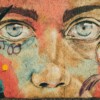In the first part of this essay, I described how the twenty-first-century discovery of the oldest paintings on earth in Indonesia – including the Sulawesi warty pig – illustrates the main points of Darrel R. Falk’s On the (Divine) Origin of Our Species.1 Falk starts from the more widely known European cave paintings to argue that the origin of our species was a sudden, spiritual event, one of reaching out for the divine with a newly evolved body and brain. God made us as metaphysical image-bearers through gradual, physical means, where the point is not so much how we were made but why — because God is always reaching out to those who bear His image.
Falk energetically and effectively challenges the atheistic or deistic view that God is absent from the natural processes that made the ancient artists who painted these evocative images. Rather, God is near to all those made in His image, at all times, through the imagination and their free will to turn toward or away from Him. This imagination can be scientific, literary, artistic, or all of the above.
My scientific, chemical imagination coincides with Falk’s biological imagination throughout most of the book – in fact, our imaginations significantly diverge only once, in Chapter 6. We don’t disagree about the data, but about what the data means, and about which words we should use to interpret it. I think there’s another way to challenge the default interpretation of science, not in place of Falk’s own biological hypothesis, but in addition to it.
I agree with Falk when he starts his book by challenging reductionistic models of reality that allow for scientific data and nothing else. I’m with Falk when he writes in Chapter 1, “My chief motivation is to emphasize that the hypothesis – that Jesus died and rose again – holds up well to science-like scrutiny. Not only has it not been falsified, there are logical reasons grounded in historical analysis for accepting it as a viable hypothesis, indeed even as the best explanation of the data at hand.”2
I speak from the same motivation (agreeing with many authors Falk cites in Chapter 1), but my scientific discipline of chemistry leads me to see God’s action in some places, or more specifically times, that are neglected by Falk’s discipline of biology. Falk focuses on God’s action a hundred or two thousand years ago at the origin of our species, while I focus on God’s action billions of years ago at the origin of the periodic table.
From this standpoint, I collegially challenge some of Falk’s statements in Chapter 6, titled “The Origin of Our Species and Providence,” when Falk holds to a highly contingent view of natural history. On this interpretation, Falk is in sync with his field, as he writes, “The nearly unanimous consensus within the field of evolutionary biology is that the arrival of Homo sapiens – when viewed through a naturalistic lens – would not have happened were it not for a lot of incredibly lucky breaks.”3
Falk accepts the evolutionary biologists’ conclusion about the nature of the evolution of Homo sapiens, but sees the Spirit’s hand in nudging the atoms to accomplish God’s purposes: “The origin of our species is grounded – not in luck – but in the providence of God.”4 I agree, but I have a different emphasis, which came first from my disciplinary orientation as a chemist, and was reinforced by the Sulawesi warty pig paintings in Indonesia that predate Falk’s European cave art.
Do the two sites of ancient cave art, located half a world apart, imply two imaginative “explosions”? I suppose it’s possible that artists traveled the 10,000 miles from Sulawesi to Chauvet during the ~10,000 years between the oldest Indonesian art and the oldest European art. It’s also possible art emerged in Africa before humans migrated about 60,000 years ago,5 with evidence for this still buried. But in my opinion, the simplest explanation (given current evidence) is that both communities had the flash of artistic inspiration independently, maybe even catalyzed by their arduous and divergent journeys out of Africa.
I think art was destined to unfold as questing humans found colored rocks. Both sets of ancient artists even used the same iron ochre chemical as a pigment, because it’s the easiest and best pigment that the periodic table made available. Chemistry shaped their choices, so much that the art they made looks the same, because they were working from the same palette of earth-tone oxides, upon the same “canvas” of limestone.
In my book A World from Dust: How the Periodic Table Shaped Life,6 I address how many of the same transitions in evolution that Falk calls “lucky breaks” may in fact be encoded in chemical laws from the beginning of creation, connecting the logically changing chemistry of the environment to the randomly changing fluctuations of genes. The presence of ancient cave art in two widely separated communities suggests that the transition to human consciousness was more than a “lucky break.” If this transition was as contingent as Falk thinks, then it’s weird that it happened twice.
Falk cites Stephen Jay Gould and other biologists to back up his claim of contingency. In my book, I argue against Gould’s claims, and now I can also cite the chemist Ilya Prigogine to back up my claim of a large-scale predictability and order: “The history of any particular animal species will appear very contingent, dependent on other species and on environmental accidents. Nevertheless, the feeling persists that, as such, the overall pattern of a tropical forest, as represented, for instance, by the diversity of species, corresponds to the very archetype of order.”7
This difference of opinion between the biologists and the chemists is not a primary question – that God did it will always be more important than how. The answer is very possibly “both/and.” God works in different ways at different levels. I like to think God both created a universal chemical sequence for chemists to figure out, and providentially nudged atoms toward genetic “lucky breaks” to make Homo sapiens, for biologists to figure out. The chemical level and the biological level of explanation do not coincide, but neither do they contradict.
We have practice in reading nature on different levels because we already read scripture on different levels. Sometimes scripture-readers focus on a single word, or even a letter within that word, like chemists consider a single atom or biologists consider a single genetic mutation. Sometimes scripture-readers focus on the grand themes and systems of Scripture’s narrative, like chemists and biologists consider the broad scope of natural history, with its general laws and lucky breaks. Both types of reading are valid.
To find out how God worked in the world, we can search for these scientific and artistic treasures scattered throughout the globe, to trace the time when the candle of consciousness was first lit in dim caves. Our search is costly – it might take everything we can give. We need more than one discipline to find it so that artists, biologists, and chemists need each other. Our faith seeks understanding and trusts that the God in which we live and move and have our being exists at and speaks into every level of space and time.
Footnotes
- Darrel R. Falk. On the (Divine) Origin of Our Species. (Wipf and Stock Publishers, 2023).
- Falk, On the Origin, 37.
- Falk, On the Origin, 177.
- Falk, On the Origin, 184.
- Michael Price, “Ancient humans traveled half the world to Asia before main migration out of Africa” Science, June 13, 2023, doi: 10.1126/science.adj2192. https://www.science.org/content/article/ancient-humans-traveled-half-world-asia-main-migration-out-africa
- Benjamin J. McFarland, A World from Dust: How the Periodic Table Shaped Life (Oxford University Press, 2016).
- Ilya Prigogine and Isabelle Stengers. Order Out of Chaos: Man’s New Dialogue with Nature (Verso Books, 2018), 169.
























Simon Conway Morris has likewise argued that much of the course of biological evolution is highly constrained by the laws of nature. Part of the difference lies in semantics and individual perception, though. Gould’s position would lead to saying things like “if we could replay evolution from the early Cambrian, maybe the mollusks would be the dominant large land animals instead of vertebrates! How random!” and Conway Morris is pointing out that those large land mollusks would have a lot of similarity in form to large land vertebrates because they are dealing with the same basic physical constraints, very non-random. This difference in perception ties into ideas on determinism, free will, predestination, etc. Although many (including Gould) have claimed that the scientific data favor their position on determinism versus free will, in reality it’s easy to think of deterministic and non-deterministic interpretations of the same event. Likewise, it’s easy to claim either determinism or free will supports many of one’s other positions. As long as we recognize that “random” events are under God’s control and guidance, we can be flexible in what we perceive as more or less “random”.
I definitely think being “driven from within,” with creation having an integrity given it by its Creator, is one of the main themes I’d like to recover. This argues against both God of the gaps, and against people who say it’s all chance and contingency. As to how it all comes together, it’s interesting. The concept of entropy driving reactions means there’s contingency at the low level of individual atoms interacting/efficient cause, which I think Falk focuses on, but entropy also means there’s an inevitable, predictable distribution to how all these atoms come together, when you look at them as a whole. So individual contingency but group predictability = formal cause, even final cause. But, yes, I want to remind us scientists that just because individual events are random, that doesn’t escape providence. Falk says that in one way, I say it in another.
First of all, I want to express appreciation to Ben for this very nice summary of our common interest–his from chemical perspective and mine from the perspective of a biologist. I think it’s important that I clarify one aspect of what I wrote in the book. On page 89 (Kindle version), I wrote “It was the expansion of the mentalizing circuitry in the Sapiens’ brains that brought it to its current level of sophistication, and mostly, based on the analysis of ancient skull morphology, this had largely taken place by 200,000 years ago. Anthropologists put great emphasis on the importance of this capacity in shaping our capacity for language, art, religion, and culture in general.” In other words, I was not suggesting that what we have today–art on cave walls–corresponds to the actual *time* when scholars think there was a significant change in the brain. Rather, they think it likely occurred much earlier–prior to the time when Sapiens migrated out of Africa. Indeed on page 116 I emphasized the possibility (if not likelihood) that making art-on-cave-walls originated in Africa prior to the northward migration. So I really think that Ben and I are on the same page!
Just as an aside, Ben’s comments about entropy in his reply (above) to David Campbell are highly prescient to some work I’m doing on the ideas of the biologist/priest Teilhard de Chardin. I think biologists and chemists are on the same page in all sorts of ways. 🙂